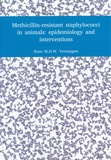Methicillin-resistant staphylococci in animals
Epidemiology and interventions

Verstappen, Koen
- Promoter:
- Prof.dr. J.A. (Jaap) Wagenaar
- Co-promoter:
- Dr. B. (Birgitta) Duim & dr. A.C. (Ad) Fluit
- Research group:
- Wagenaar
- Date:
- May 11, 2017
- Time:
- 10:30 h
Summary
Antimicrobial resistance in bacteria is a global problem. Important organisms are methicillin-resistant Staphylococcus aureus (MRSA), which is widespread among pigs, and Staphylococcus pseudintermedius (MRSP), which is an important pathogen in dogs and cats. Infections with these organisms can be difficult to treat. Livestock-associated MRSA (LA-MRSA) can be transmitted from pigs to humans, and measures to reduce the transmission are warranted. The aim of this thesis was to study the epidemiology of MRSA and MRSP and intervention approaches that could reduce colonization of LA-MRSA in pigs. First,a model was developed for nasal colonization of MRSA in piglets. It was studied if bacteriophages, viruses that kill bacteria, could reduce MRSA colonization. No reduction of MRSA was observed after application of bacteriophages. However,bacteriophages were effective to kill MRSA in the laboratory. This might be due to the presence of mucus in piglets that inhibit the effect of bacteriophages. Another approach was to study if different genetic lineages of pigs have a different susceptibility for colonization by S. aureus. In one of the tested lineages less S. aureus-positive animals were observed than in the other lineages. Theoretically this might offer possibilities in the breeding programme to reduce S. aureus, including LA-MRSA, in pigs. S. aureus colonization may be influenced by other bacteria. Therefore, the developing microbiome in the pig’s nose was studied. S. hyicus, S. cohnii, and S. saprophyticus were found to be rarely present together with S. aureus. It is possible that these bacteria inhibit S. aureus colonization. Furthermore, nine bacterial genera were associated with the presence or absence of S. aureus and 31 were associated with the presence or absence of MRSA. Most important was the association of Moraxella with the absence of MRSA. MRSA in pigs in Sri Lanka was also studied and was isolated from 6/493 tested pigs. The low number of positive animals may result from the small size of farms and the housing methods. The MRSA isolates that were found in humans in Sri Lanka were of different genotypes than the MRSA isolates from pigs. This suggests that MRSA from pigs is not associated with the presence of MRSA in the community and hospitals in Sri Lanka. In the second part of the thesis the epidemiology of methicillin-resistant S. pseudintermedius (MRSP) among dogs was shown to result from clonal spread, and the types of MRSP that are found in dogs in the Netherlands are changing towards types that are more susceptible to antimicrobials. Among dogs in Sri Lanka MRSP isolates were found that were resistant against many antimicrobials. We also identified variation in the Staphylococcal Chromosome Cassette mec (SCCmec), which carries the mecA gene (confers methicillin resistance). This indicated that the cassette of S. pseudintermedius is changing and that novel types continue to be encountered. Current diagnostic tests are insufficient for correct identification of this species. By using a novel automated method for comparing genome sequences of staphylococci a DNA sequence was identified that is specific for S. pseudintermedius, which was used to develop the new diagnostic test.